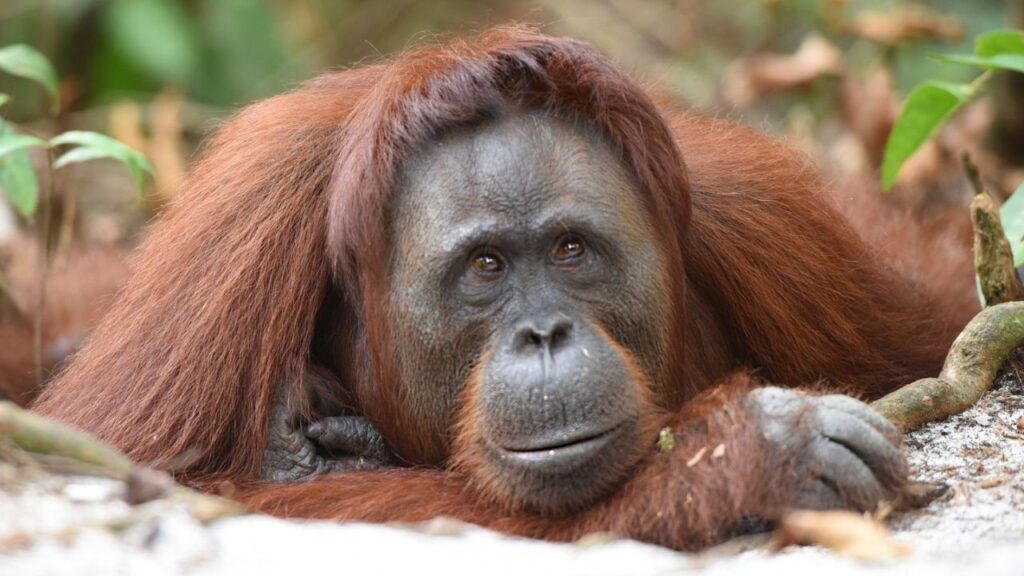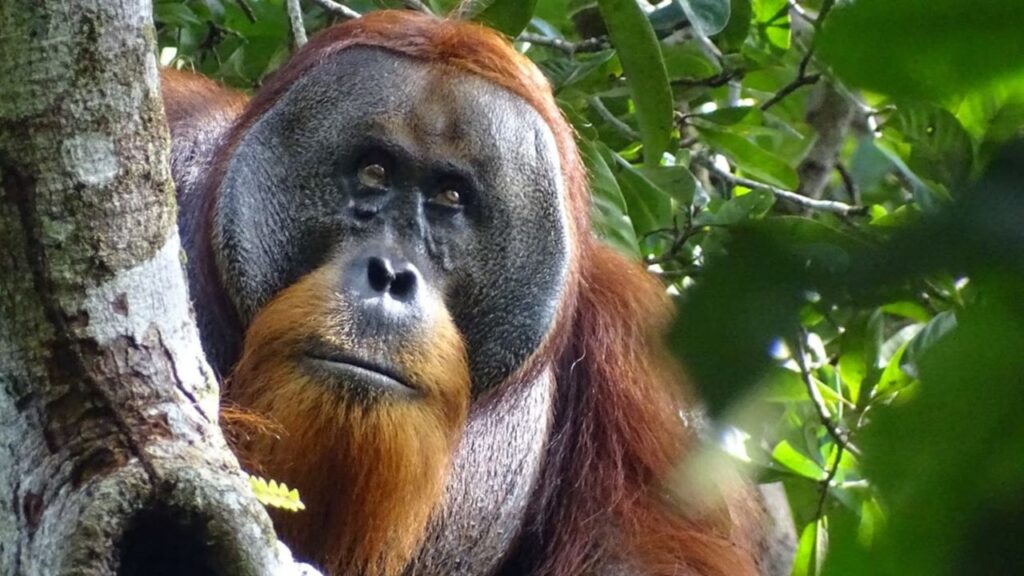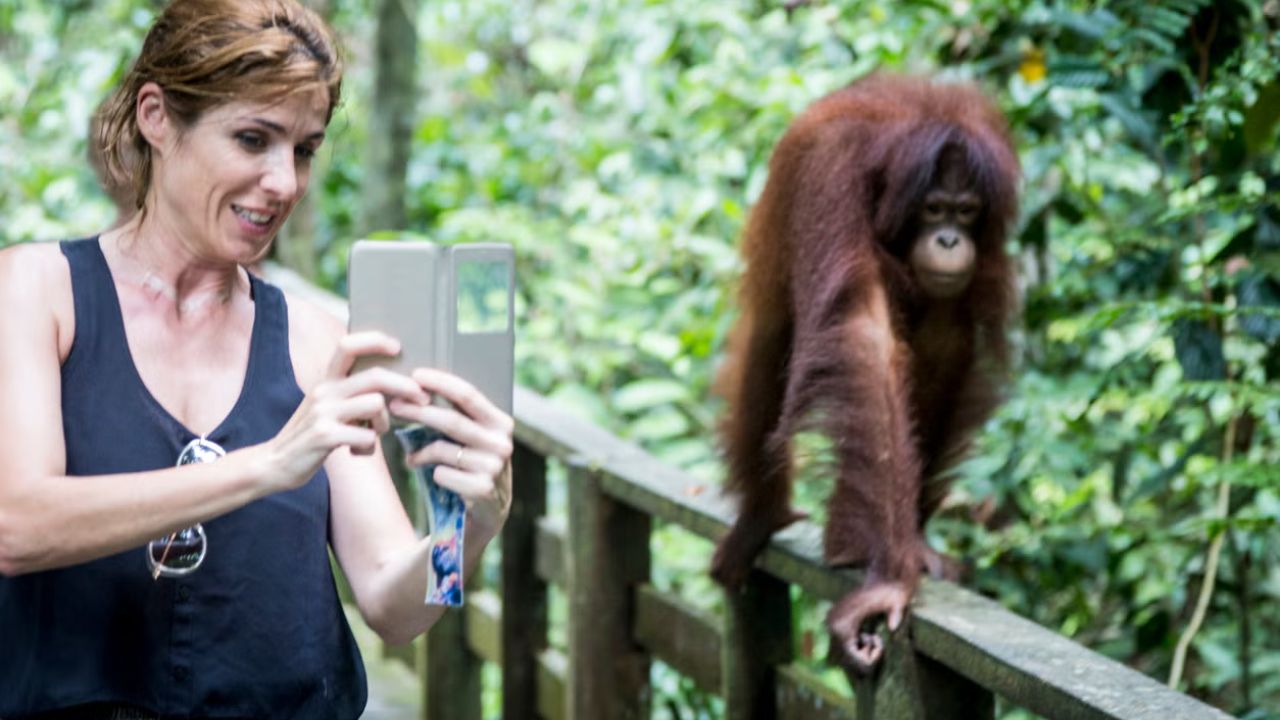Do Orangutans Attack Humans? Orangutan attacks on humans are rare but can occur, typically in situations where the animals feel threatened or are provoked.
Orangutans are one of the most intelligent and gentle creatures in the animal kingdom.
Found in the rainforests of Borneo and Sumatra, these great apes are known for their distinctive reddish-brown hair and remarkable ability to use tools.
However, like any wild animal, there are concerns about how they interact with humans.
This article explores the question: Do orangutans attack humans? We’ll delve into their behavior, the reasons behind any potential aggression, and how humans can coexist peacefully with these magnificent creatures.
Contents
What Are Orangutans?
1. Overview of Orangutans
Orangutans are large apes native to the islands of Borneo and Sumatra in Southeast Asia. They are the largest arboreal mammals, meaning they spend most of their time in trees.
There are three species of orangutans: the Bornean orangutan, the Sumatran orangutan, and the Tapanuli orangutan. These intelligent creatures share about 97% of their DNA with humans, making them one of our closest relatives in the animal kingdom.
Orangutans are known for their incredible intelligence. They have been observed using tools, such as sticks to extract insects from tree bark or leaves to protect themselves from rain.
Their problem-solving abilities and capacity to learn from observation make them one of the most advanced non-human species in terms of cognitive function.
In the wild, orangutans live a mostly solitary life, which contrasts with the more social behaviors of other great apes like chimpanzees. [Do Orangutans Attack Humans?]
They are highly dependent on their forest habitat, where they find food, shelter, and the necessary materials for their day-to-day survival. Their diet mainly consists of fruit, but they also eat leaves, bark, and insects.
2. Social Behavior of Orangutans
Unlike many primates, orangutans are generally solitary animals. Adult males typically live alone, while females are more likely to be seen with their offspring. Despite their solitary nature, orangutans are not aggressive by default.
They are usually peaceful and avoid confrontations unless provoked or threatened. [Do Orangutans Attack Humans?]
Orangutans have a slow reproduction rate, with females giving birth only once every 7 to 9 years. This slow rate of reproduction, combined with habitat loss, makes orangutans particularly vulnerable to population decline.
Their social structure and behavior are adapted to their environment, where food sources are scattered, and the dense forest canopy provides protection.
In captivity, orangutans often exhibit different social behaviors due to the proximity of other orangutans and humans.
They can form bonds with their caretakers and other orangutans, although their natural tendency towards solitude remains evident. Understanding the social behavior of orangutans is crucial for anyone who may encounter them in the wild or in captivity.

Why Do Orangutans Attack Humans?
1. Rare Instances of Aggression
Orangutan attacks on humans are rare but not entirely unheard of. In the wild, these apes are more likely to flee than fight when they encounter humans. [Do Orangutans Attack Humans?]
However, there have been instances where orangutans have exhibited aggressive behavior towards humans. These incidents are typically the result of the orangutan feeling threatened or cornered.
For example, if a mother orangutan perceives a threat to her offspring, she may become aggressive in an attempt to protect her young.
Similarly, an adult male orangutan might show aggression if he feels his territory is being encroached upon. It’s important to note that such attacks are almost always defensive rather than predatory.
In some cases, aggression can also occur in captivity. Orangutans kept in inadequate conditions, without proper stimulation or space, may become stressed and exhibit aggressive behaviors towards their caretakers or visitors.
This underscores the importance of providing appropriate environments for orangutans in captivity to ensure their well-being and safety. [Do Orangutans Attack Humans?]
2. Common Triggers for Aggression
Several factors can trigger aggression in orangutans. Understanding these triggers is essential for anyone working with or encountering orangutans, as it can help prevent potentially dangerous situations. The most common triggers include:
- Encroachment on Territory: Orangutans are territorial animals, especially adult males. If a human enters their territory, they may perceive it as a threat and respond with aggression. This is particularly true during mating season, when males are more likely to defend their territory against rivals.
- Feeling Cornered: If an orangutan feels trapped or unable to escape, it may resort to aggression as a last resort. This can happen in situations where orangutans are caught in a conflict with humans, such as when they wander into agricultural areas or villages.
- Protecting Offspring: Female orangutans are highly protective of their young. Any perceived threat to their offspring can trigger an aggressive response. This maternal instinct is strong in orangutans, as their slow reproduction rate makes each offspring crucial for the species’ survival.
- Stress in Captivity: Orangutans in captivity can exhibit stress-related behaviors, including aggression, particularly if they are not provided with adequate enrichment or space. Stress can lead to frustration and anxiety, which may manifest as aggressive behavior towards humans or other orangutans.
- Past Trauma or Abuse: Orangutans that have been rescued from the illegal pet trade or other abusive situations may carry psychological scars that make them more prone to aggression. These animals require special care and attention to help them recover from their past experiences.
Understanding these triggers is crucial for anyone interacting with orangutans, whether in the wild, in sanctuaries, or in captivity.
By recognizing the signs of potential aggression, humans can take steps to de-escalate the situation and avoid provoking the animal. [Do Orangutans Attack Humans?]
Human-Orangutan Interaction
1. How Humans and Orangutans Interact
Humans and orangutans can interact in various ways, including in the wild, in sanctuaries, or in captivity. Each type of interaction carries its own set of risks and benefits, and understanding these can help minimize the potential for conflict.
In the wild, most encounters are brief and non-aggressive, with orangutans often retreating at the sight of humans.
However, in areas where orangutan habitats overlap with human settlements, such as in parts of Borneo and Sumatra, there is a higher chance of encounters. These encounters can sometimes lead to conflicts, particularly if the orangutans have lost their natural habitat due to deforestation or other human activities.
In sanctuaries or rehabilitation centers, where orangutans are cared for by humans, the interactions can be more frequent and close. [Do Orangutans Attack Humans?]
These settings often require careful management to prevent any potential aggression, especially as the orangutans grow older and more territorial. Sanctuary workers are trained to handle these situations, but visitors must also follow strict guidelines to ensure their safety and the well-being of the animals.
Captive orangutans, such as those in zoos, may interact with humans more regularly. These interactions are usually controlled and supervised, but they still carry risks, especially if the orangutan is stressed or has a history of aggression.
Zoos and sanctuaries often implement enrichment programs to keep the orangutans mentally and physically stimulated, which can reduce the likelihood of aggression. [Do Orangutans Attack Humans?]

2. Safety Measures for Humans
To safely observe or interact with orangutans, it’s essential to follow specific guidelines. These measures not only protect humans but also ensure the safety and well-being of the orangutans. Here are some key safety tips:
- Maintain a Safe Distance: Always keep a respectful distance from orangutans, especially in the wild. Approaching too closely can be seen as a threat, which may provoke an aggressive response. In most cases, a distance of at least 10 meters is recommended.
- Avoid Provocation: Do not attempt to feed or touch orangutans. Even if they appear friendly, sudden movements or loud noises can provoke an aggressive response. It’s essential to remember that orangutans are wild animals, and their behavior can be unpredictable.
- Respect Their Habitat: Avoid encroaching on orangutan habitats, especially when traveling in their natural environment. Sticking to designated paths and avoiding areas known to be orangutan territories is crucial. This helps minimize the chances of an accidental encounter that could lead to conflict.
- Observe with Caution in Captivity: If visiting a sanctuary or zoo, always follow the guidelines provided by the staff. Do not attempt to interact with orangutans without supervision. Even in captivity, orangutans retain their wild instincts and may react aggressively if they feel threatened.
- Stay Calm and Avoid Sudden Movements: If you find yourself in close proximity to an orangutan, stay calm and avoid making sudden movements. Back away slowly and give the animal plenty of space to retreat. Never run or make loud noises, as this could trigger a defensive response. [Do Orangutans Attack Humans?]
- Understand the Signs of Aggression: Learn to recognize the signs of aggression in orangutans, such as vocalizations, baring teeth, or raising their arms. If you notice any of these behaviors, it’s best to increase your distance and give the orangutan space to calm down.
Following these safety measures can significantly reduce the risk of an aggressive encounter with an orangutan. Respecting their space and understanding their behavior is key to peaceful coexistence.
Role of Conservation Efforts
1. Reducing Human-Orangutan Conflicts
Conservation efforts play a crucial role in reducing human-orangutan conflicts. As human populations expand and encroach on orangutan habitats, the risk of encounters increases. Conservation initiatives aim to protect and preserve the natural habitats of orangutans, thereby minimizing the chances of human-wildlife conflict.
Programs that focus on reforestation, habitat protection, and sustainable land-use practices are vital in ensuring that orangutans can thrive in the wild without coming into conflict with humans. These efforts also include educating local communities on how to coexist peacefully with orangutans.
One successful example of such efforts is the creation of wildlife corridors, which connect fragmented habitats and allow orangutans to move freely without encountering human settlements. These corridors are essential for maintaining healthy populations of orangutans and reducing the likelihood of conflict.
2. The Importance of Protecting Orangutan Habitats
One of the most effective ways to prevent orangutan-human conflicts is by protecting their natural habitats. Deforestation and illegal logging are significant threats to orangutan populations. When their habitats are destroyed, orangutans are forced to move closer to human settlements in search of food and shelter, leading to increased encounters and potential conflicts.
Protecting these habitats involves not only conserving the forests where orangutans live but also addressing the root causes of deforestation, such as the demand for palm oil, timber, and agricultural land.
By promoting sustainable practices and supporting companies that prioritize environmental stewardship, consumers can play a role in preserving orangutan habitats.
Additionally, governments and international organizations can implement policies and regulations that protect critical orangutan habitats from exploitation.
This includes enforcing anti-logging laws, establishing protected areas, and supporting reforestation projects that restore degraded habitats.

3. Supporting Orangutan Conservation Initiatives
Supporting organizations and initiatives dedicated to orangutan conservation is another way to help these great apes. [Do Orangutans Attack Humans?]
Many non-profit organizations work tirelessly to protect orangutans from habitat loss, poaching, and the illegal pet trade. By donating to or volunteering with these organizations, individuals can contribute to the preservation of orangutans and their habitats.
Conservation initiatives also focus on research, rehabilitation, and the reintroduction of orphaned or displaced orangutans into the wild. These efforts are critical for ensuring the long-term survival of orangutan populations.
Organizations like the Orangutan Foundation International, the Borneo Orangutan Survival Foundation, and the Sumatran Orangutan Conservation Programme are leading the charge in these conservation efforts.
By supporting these organizations, you can help fund the protection of orangutan habitats, the care of orphaned orangutans, and the fight against illegal wildlife trafficking.
In addition to financial support, raising awareness about the plight of orangutans is crucial. Educating others about the threats facing orangutans and the importance of conservation can inspire more people to take action.
Social media campaigns, educational programs, and advocacy efforts all play a role in building a global movement to protect these incredible animals.
Final Verdict
Orangutan attacks on humans are extremely rare and usually occur only when the animals feel threatened or cornered. [Do Orangutans Attack Humans?]
These gentle giants are typically peaceful and prefer to avoid conflict. However, respecting their space and avoiding provocation is essential to prevent any potential aggression.
Conservation efforts are vital in reducing human-orangutan conflicts and protecting these incredible animals. By supporting habitat preservation, sustainable practices, and conservation organizations, we can ensure that orangutans continue to thrive in the wild for generations to come.
See Also: Do Roadrunners Attack Humans? Debunking Myths!
FAQs
Are orangutans dangerous to humans?
Orangutans are generally not dangerous to humans. They are peaceful creatures, but they may become aggressive if they feel threatened or provoked.
What should I do if I encounter an orangutan in the wild?
If you encounter an orangutan in the wild, maintain a safe distance, avoid making sudden movements, and do not attempt to interact with the animal.
How common are orangutan attacks on humans?
Orangutan attacks on humans are very rare and usually occur only under specific circumstances, such as when the animal feels threatened.
Why might an orangutan attack a human?
An orangutan might attack a human if it feels cornered, threatened, or if it perceives a threat to its offspring. [Do Orangutans Attack Humans?]
Can orangutans be aggressive in captivity?
Orangutans in captivity can exhibit stress-related behaviors, including aggression, especially if they are not provided with adequate enrichment or space.
Conclusion: Do Orangutans Attack Humans?
In conclusion, while orangutan attacks on humans are rare, they can occur in certain situations where the animals feel threatened or provoked. [Do Orangutans Attack Humans?]
By understanding their behavior and respecting their space, humans can coexist peacefully with these incredible creatures. Conservation efforts are vital in protecting orangutans and ensuring that they can thrive in their natural habitats without coming into conflict with humans.
Supporting conservation initiatives, protecting orangutan habitats, and raising awareness about the challenges facing these great apes are all critical steps in ensuring their survival.
With the right efforts and attitudes, we can help secure a future where orangutans continue to live peacefully in the wild, free from the threats of habitat loss and human conflict.

Hello, I am Rosa Ellis, a mother of two and a wildlife blogger. I grew up in New York City, but I love exploring forests. I’ve traveled to places like Yellowstone National Park and the Amazon Rainforest to see animals up close. I know a lot about animal behavior and which animals can be dangerous to humans. Thanks for visiting my blog!

